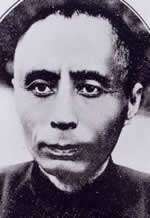Zang Shiyi
Zang Shiyi (Chinese: 臧式毅; pinyin: Zāng Shìyì; Wade–Giles: Tsang Shih-i Hepburn: Zō Shikiki; October 1884 – November 13, 1956) was a Chinese general and Governor of Liaoning Province at the time of the invasion of Manchuria in 1932.
Zang Shiyi 臧式毅 | |
|---|---|
 Zang Shiyi, Speaker of the Manchukuo Senate | |
| Born | October 1884 |
| Died | November 13, 1956 |
| Other names | Tsang Shih-i |
| Citizenship | Manchukuo |
Biography
Zang was born in Shenyang county of Liaoning Province in 1884. He traveled to Japan on a scholarship to the Tokyo Shimbu Gakko and subsequently graduated from 9th class of the Imperial Japanese Army Academy, with a specialty in the cavalry, in 1909. On his return to China he joined the pro-republican forces in Nanjing during the Xinhai Revolution.
After the founding of the Republic of China in 1914 he became an instructor at the Baoding Military Academy, where he soon caught the attention of Adm. Sheng Hung Leih, who appointed him to his staff. He rose to Chief of Staff for the Kuomintang forces in Kirin Province. He participated in the Zhili–Anhui War in 1920 and the First Zhili–Fengtian War of 1923. Together with Yan Yuting, he subsequently became Chief of Staff of the business administration section of the Kuomintang National Revolutionary Army headquarters in Nanjing.
After the death of Manchurian warlord Zhang Zuolin, Zang supported the Chinese Reunification Movement and was appointed governor of Liaoning Province in 1930.
After the Mukden Incident Zang initially refused to cooperate with the Imperial Japanese Army and was imprisoned. However, he later decided to defect and was re-appointed governor of Liaoning Province (renamed Fengtien Province) on 16 December 1931. He was part of the Northeastern Administrative Committee or "Self-Government Guiding Board that made plans for a new State of Manchukuo to be established in February 1932.
In 1932 Zang was re-appointed governor of Fengtian Province of Manchukuo, a position he retained after the administrative reorganization of the provinces of Manchukuo from four to ten provinces in October 1934. In March 1935 he was Emperor Puyi's first choice to replace Zheng Xiaoxu as Prime Minister of Manchukuo (although Zhang Jinghui was appointed instead at the insistence of the Japanese Kwantung Army leadership). From 21 May 1935 Zang served in the largely ceremonial role as Speaker of the Manchukuo Senate—a post which he held until the collapse of Manchukuo in August 1945. He later served as Vice Minister for Home Affairs.
In 1940 Zang was appointed ambassador to the Reorganized National Government of China headed by Wang Jingwei, and on 30 November 1940 he signed the Japan-Manchukuo-China joint declaration for Manchukuo, in which the Wang Jingwei regime recognised the country. It was part of the Basic Treaty by which Japan recognised the Reorganised National Government.[1]
Following the Soviet invasion of Manchuria, he declared an emergency session of the Manchukuo legislature to promulgate the abdication of Emperor Puyi on 17 August 1945, effective 18 August, and attempted to open negotiations with the Soviet Union. However, the Manchukuo capital of Hsinking fell to the Red Army on 20 August 1945, and Zang was captured ten days later. He was initially held in custody in Siberia, but was extradited to the People's Republic of China in 1950, where he died of illness in captivity at the War Criminals Management Centre in Fushun, Liaoning, on 13 November 1956.
References
- Rana, Mitter (2000). The Manchurian Myth: Nationalism, Resistance, and Collaboration in Modern China. University of California Press. ISBN 0-520-22111-7.
- Yamamuro, Shinichi (2005). Manchuria Under Japanese Domination. University of Pennsylvania Press. ISBN 0-8122-3912-1.
External links
| Wikimedia Commons has media related to Zang Shiyi. |